Wired networks play a critical role in today’s technology-driven world, connecting devices and enabling seamless communication and data transfer. However, the complexities associated with wired networks present significant challenges. In this blog, we delve into the intricacies of wired networks and detail how Juniper Mist Wired Assurance alleviates burdens, streamlines processes and ensures successful network deployment and operation through automation and smart planning. By embracing the Juniper Mist flexible configuration templates, dynamic port profile and zero-touch provisioning, organizations can optimize their wired network planning, reduce complexities and achieve desired outcomes efficiently and confidently.
Why Planning Matters
Planning isn’t easy. If only wired networks were totally uniform, things might be easier, but across sites and tiers, enough variance exists, which creates a diverse landscape that demands both meticulous planning and preparation. With greater complexity comes increased risk and uncertainty. Volatility and scale become an even greater burden, and encountering speed bumps or roadblocks slows teams down. Leadership and stakeholder confidence can be easily chipped away. Designing for new projects, especially with orchestration at scale, also comes with an uncomfortable heaviness that can feel taxing and heavy rather than light and full of possibility.
Many of these feelings come down to deficits in preparation and planning. As Yogi Berra famously quipped, “If you don’t know where you are going, you’ll end up someplace else.” Yet, with confidence and trust in the right tools, the processes of network planning, provisioning and deployment can be radically altered. Simplification and streamlining allow assurances to be made and service promises to be kept.
Day 0: Fail to Prepare, Prepare to Fail
With planning and preparation being the primary keys to success, additional optimization and compression of these phases deliver more time for dealing with stakeholders, inevitable exceptions and any unavoidable delays that surface. Optimized planning and preparation not only allow IT teams to “bank” extra time but also heighten the speed and quality of outcomes.
By leveraging repeatable patterns and smarter configuration templates, automation can also be embraced and leveraged earlier than previously thought. Sites and services that traditionally took hours and days to “go-live” can be planned and prepped in minutes. New and evolved capabilities that simplify design, reduce toil and increase velocity confine. So, what features can actually reduce and simplify the planning and provisioning for a thousand or more sites?
Flexible Configuration Templates
As mentioned in Campus Fabric Fundamentals: Simpler, Better, Faster, Stronger, templates accelerate configuration. They provide something to start with, while flexible configuration templates help enable smarter and safer work. A simple hierarchy makes it possible to rapidly create a malleable model for the entire footprint. At the top level, there are organization settings, then site-specific ones, and finally, switch-specific configs for “pets” or “snowflakes.” This simple hierarchical model keeps any minor, major or bulk updates robust and dependable.
Whether provisioning from scratch or making changes at scale using the graphical user interface (GUI) or application programming interface (API), the most explicit configs are applied based on hierarchy to ensure consistency. By creating flexible group templates, wherever there is a contradiction or overlap, the most specific or narrow template wins based on hierarchy. This means core settings like radius, DNS, NTP, routing and syslog, among others (including specific CLI commands), can be set at an organization level, with any remaining specifics set at an individual site or switch level.
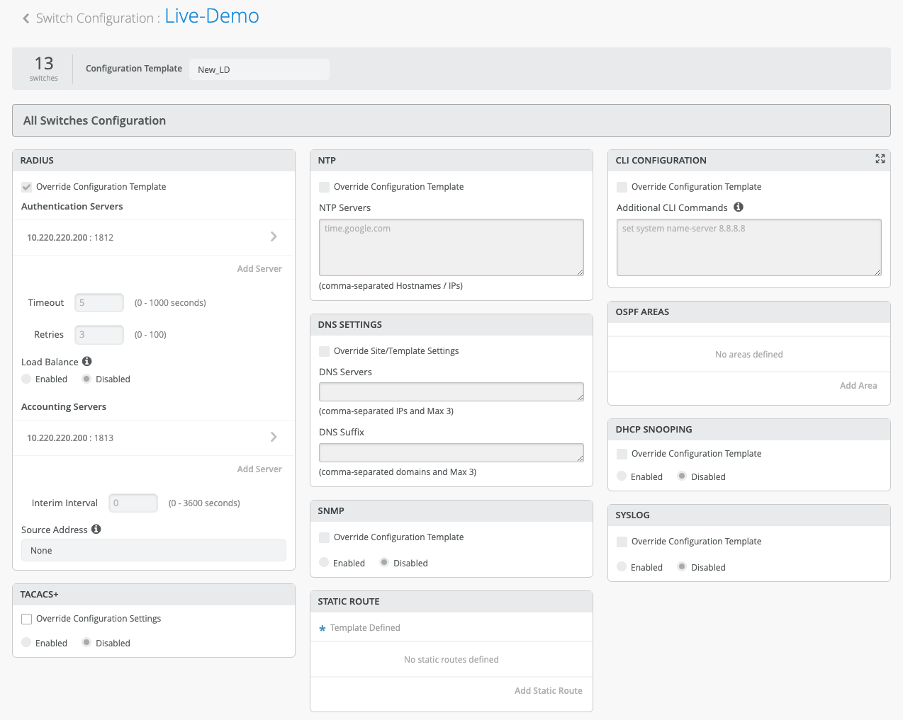
Port Profiles with Dynamic Port Configuration
Ensuring the right wired ports get the correct configuration and treatment is paramount both from an operational and security perspective. Port assignments are generally thought of as static (which is always an option), but a lot can change during a build or across a morphing and extensive access edge. By abstracting port configurations using smart dynamic rules; moves, adds and changes become trivial, as does error reduction. Dynamic port configuration rules are easy to add, and they become powerful allies at scale. Simplifying and automating endpoint and infrastructure port connectivity configuration not only saves time but also typos and rework.
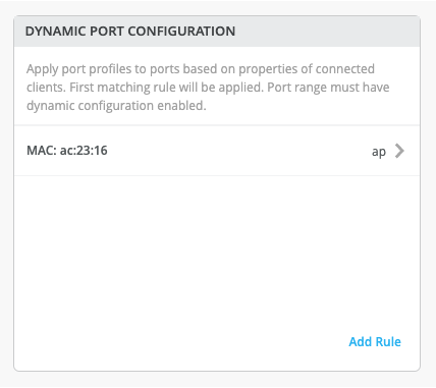
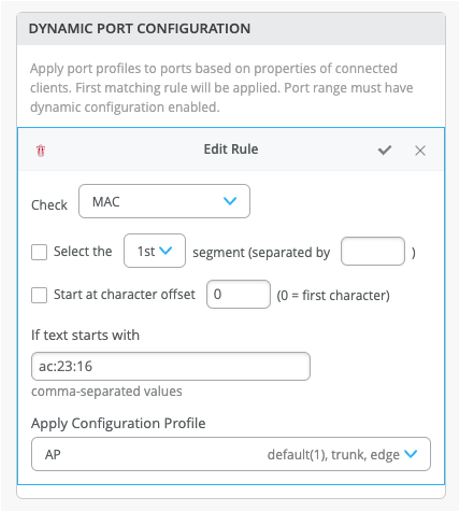
Subject to the same template hierarchies mentioned previously, these simple and powerful rules mean endpoints and infrastructure can be readily identified via a range of generic or unique characteristics. Rule logic leverages checking on attributes such as:
- LLDP Chassis ID
- LLDP System Name
- LLDP Description
- Radius Username
- Radius Filter-ID
- MAC
Modular port profiles can then be applied automatically. This ensures the correct port profiles are applied to ports no matter when or where connectivity is initiated or updated.
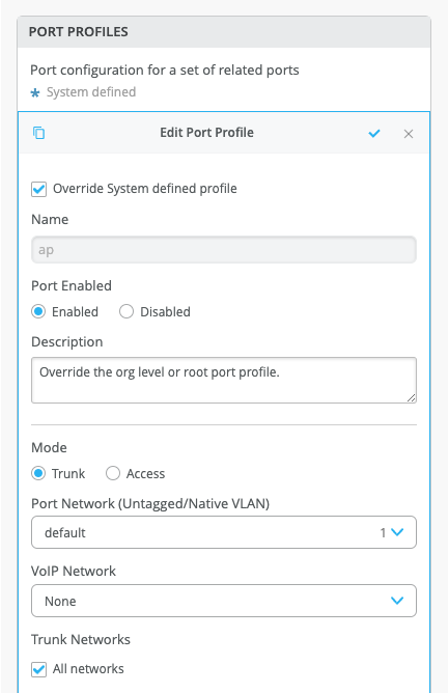
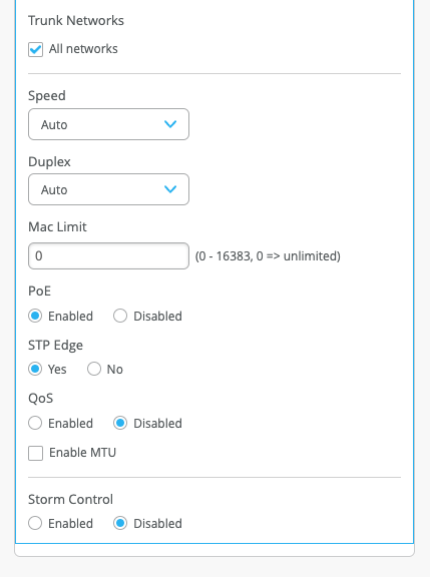
But how do we use the flexible templates and dynamic port profiles to reduce the complexity of managing dozens of individual templates?
Here are two examples demonstrated below:
1. Managing the blast radius of a migration or new configuration:
When implementing Radius services, it’s important to start slow:
- Try it on a device (override the switch config locally for the radius server config) and apply dot1x port profile on a set of test ports.
- Once it works well, remove the override on the device and expand the implementation to the entire site by overriding the radius server configurations more generally. Also apply dot1x port profiles on select ports for all switches in the site.
- When the solution is proven and bedded in – expand it to the rest of the sites, by removing the override at the site level and applying it everywhere using the organization template.
2. Port configurations:
In many organizations, port configurations may be ad-hoc and not templated even though the rest of a device configuration is.
- Global configurations rarely change (if they do, the template structure can accommodate this).
- Port configurations, on the other hand, change frequently. At Juniper, we understand this, so we split this function and configuration into two elements:
-
- “Port Profiles” that can be administered globally and inherited by switches.
- The application of “Port Profiles” to switch ports, which can also be administered locally at the switch. Super admins can allow another user role called “switch port operator” to change port configurations as needed without worrying about anything else being changed.
This is another level of flexibility and abstraction where not all port config changes require full privileges. Additionally, there is then no need to create excessive amounts of templates to achieve the configurations required.
Day 1: Move Fast and Deploy with Confidence
With a bias toward action and the right tools, deploying at scale and with increased velocity is no longer a challenge. After simplifying the planning and preparation process, deploying wired environments using Zero-Touch Provisioning (ZTP) makes Day 1 activities a breeze.
ZTP (Zero Touch Provisioning)
Historically full of toil, provisioning new infrastructure was laden with manual steps, custom cables and a lack of confidence regarding configuration. ZTP side steps outdated and cumbersome processes to leapfrog hours and days of repetitive, error-prone work.
Once a cloud-ready switch is powered on and given the required connectivity path across the Internet, it phones home for its configuration and can be adopted for ongoing management via the Juniper Mist portal. Switches can be claimed in advance via the mobile app or in the portal using switch or activation codes. Even brownfield switches can be onboarded, with more information available here.
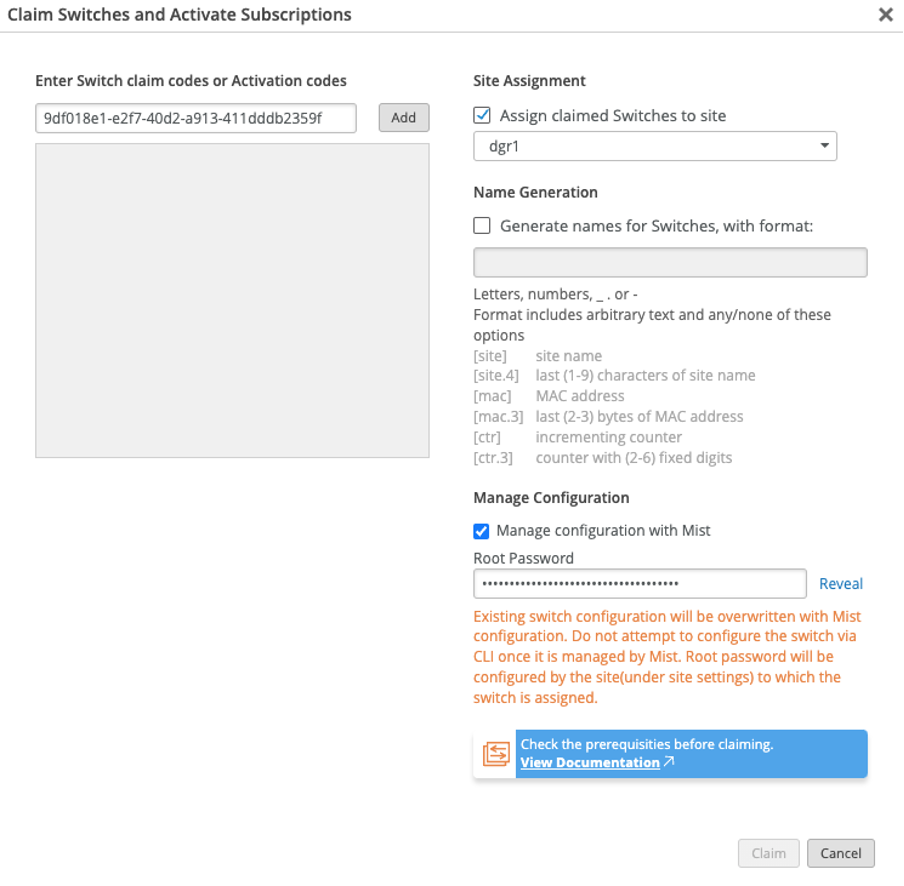 Improved experiences
Improved experiences
Optimization not only makes better use of our time but also has an outsized impact in our roles and across team borders. Technology should not make more work for us but should instead reduce workloads and allow us to get more done in a shorter span of time, leading to improved experiences.
With an accelerated time-to-value, fewer headaches and less surprises, simplified and smarter planning leads to better and faster outcomes that deliver on stakeholder happiness.
Enjoyed learning about how the Juniper Mist configuration templates, dynamic port profiling and ZTP optimizes planning, reduces complexities and improves experiences? Continue your learning and discover how the Mist cloud enables the easiest way to deploy EVPN-VXLAN Campus Fabrics! Read more here.
- Try Wired Assurance today! Click here for a free 90 day trial of Wired Assurance.
- Join our weekly demos to see how you can drive better user experiences across the wired, wireless and WAN through Mist AI!
Additional Resources:
Wired Assurance
Accelerate with Wired Assurance
























